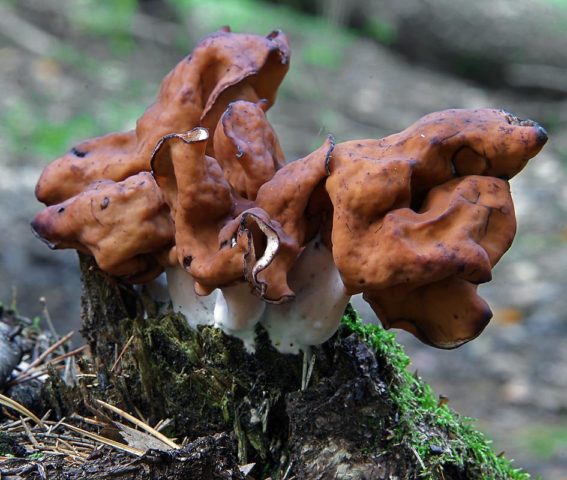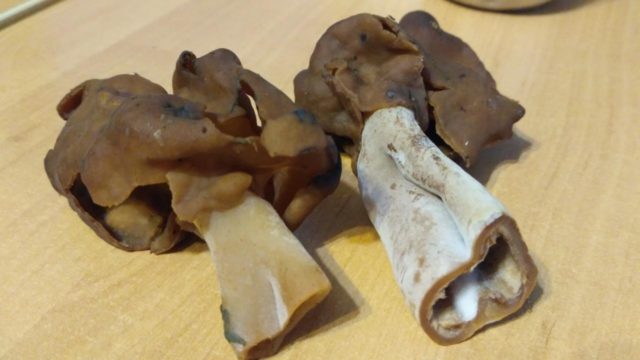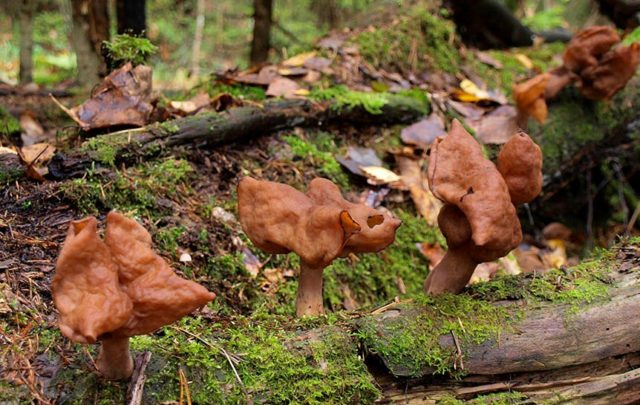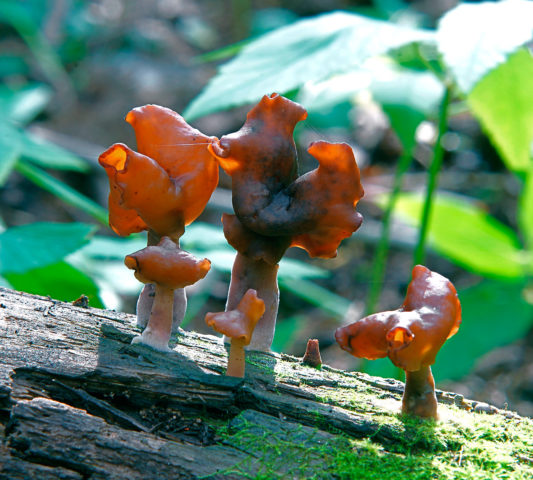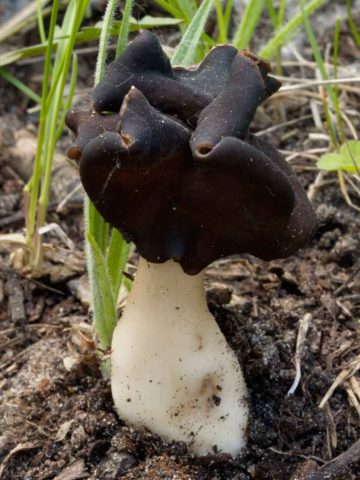Content
Lobster, or autumn line, rarely attracts the attention of mushroom pickers, and for good reason: mycologists have revealed the properties of this variety to cause severe poisoning. At the same time, the culture is used in traditional medicine recipes for external use.
Description of autumn lines
A rare autumn marsupial mushroom (lat.Gyromitra infula) belongs to the genus Lopastnikov, or Gelwell, to the Discinovye family. It is distinguished by its original appearance and medicinal properties. In Russia, the autumn line is called horned, and among the people - smarzhkom. It grows in the fall, as indicated by the name of this representative, this also distinguishes it from other Discinovids growing in spring.
Description of the hat
The horn-shaped cap of autumn stitching with a diameter of up to 10 cm surprises with its extraordinary three-horned, saddle-shaped shape and edges that grow together with the leg. An incomprehensible, irregularly shaped surface in young individuals has a light brown color, in adult lines it is dark brown, even black. The upper part of it is wrinkled, of a more saturated shade, rarely smooth. The underside is pale, velvety to the touch. The thin, even translucent flesh of the autumn line has a grayish color and emits a mushroom aroma.
Leg description
The leg of the autumn line is hollow, from 4 to 10 cm high and up to 2 cm wide, has a range of shades - from almost pure white to light brown, pinkish or gray. It is flattened from the sides, narrowed upward.
Where and how it grows
The autumn line grows in the temperate climate of central Russia and Europe, found everywhere in coniferous, deciduous or mixed forests. Most of all, this variety prefers pine thickets, where it can grow singly or in small groups on wood subject to decay or in close proximity to it. It prefers the autumn line also in mountainous terrain, however, at certain periods it massively settles on the plains. You can meet the original mushroom already from the beginning of July, but the peak of its activity is observed from the second half of August to the end of September.
Mushroom autumn line in natural conditions in the photo:
Doubles and their differences
With its shapeless hat and the size of the lines, the autumn one is outwardly similar to other representatives of the genus:
- black lobed;
- curly lobed, or white-legged.
As you can see in the photo, the color of the hat of these representatives has obvious differences. In the first double, it is, according to the name, black, and in the white-legged species it is light, almost white. Lines, like the rest of the genus, belong to inedible mushrooms, it is forbidden to eat it.
Is the mushroom edible or not
The controversy over the edibility of this species is controversial. This is due to the content in the autumn line of a poisonous substance - gyromitrin, which can destroy the human nervous system, liver and gastrointestinal tract. The toxin is so strong that its high dose is life threatening.
Gyromitrin in autumn lines is presented in various quantities. Thus, myologists have identified strains of autumn morels with an increased content of this toxin, which cannot be destroyed even by prolonged processing of the product. The distribution of the concentration of toxic substances in different populations is not fully understood, therefore, it is not possible to determine the degree of risk to life under normal conditions.
How to prepare autumn stitches
In addition to gyromitrin, overgrown, large specimens of autumn lines eventually accumulate industrial waste products, heavy metals, poisons, exhaust gases, etc. Thus, the toxicity of fruit bodies increases.
As a result, such a complex of gyromitrin content and environmentally harmful substances cannot be eliminated either during heat treatment or during drying recommended in some sources. All this makes it impossible to eat autumn stitches.
The healing properties of autumn stitches
Autumn lines are still capable of having a beneficial effect on the human body. The properties of the product have a wide range of applications in alternative medicine recipes:
- increase tone;
- improve appetite;
- anesthetize;
- have a positive effect on the work of the digestive organs, especially the pancreas.
Autumn lines (Gyromitra infula) are distinguished by a high content of toxic substances even in comparison with their spring counterparts. This is due to the time of active growth. So, the lines giant and ordinary bear fruit in the spring, when the soil and air are not yet warmed up.
Therefore, they do not accumulate as much gyromitrin as the autumn species, which is of interest to mushroom pickers only for medicinal purposes.
On the autumn lines, an alcoholic tincture is prepared, which helps with pain in the joints and in case of respiratory diseases. They use it, in particular:
- with rheumatism;
- arthrosis;
- osteochondrosis;
- radiculitis;
- bronchitis and pneumonia;
- neuralgia.
How to make a tincture on autumn lines
Attention! Alcohol tincture is used exclusively externally, after consulting with your doctor.
Mushroom home remedy is prepared from autumn stitches collected in dry, sunny weather. For this, large specimens are used that have accumulated a sufficient amount of a poisonous and at the same time healing (if used correctly) substance.
Step by step preparation of the tincture:
- Autumn stitches in the amount of 200 g are cleaned and crumbled by hands
- Put in a half-liter jar or glass bottle.
- Pour 0.3 liters of vodka or alcohol, seal with a lid.
- Put in the refrigerator for infusion for 14 - 20 days.
- The tool is used without filtering.
- Store in a cool, dark place.
The lines contain a natural type of cortisol, which has an anti-inflammatory effect.
Rules for the use of tincture
In case of pain in the joints or a strong cough, the tincture from the stitches is rubbed into the sore spots, into the chest, then the body is wrapped with woolen cloth. Do this 3 times a day until the pain subsides or the cough subsides. Despite the fact that gyrometrin is considered a poison, it is he who has a strong analgesic effect.Its greatest amount is found in overgrown, large autumn lines, which grew in dry, warm weather.
The video will tell you how to treat with lines and properly prepare the drug at home:
Contraindications to the use of autumn lines
Stitches and remedies prepared on their basis should not be used:
- pregnant women;
- nursing mothers;
- children;
- people suffering from cardiovascular diseases;
- if you are allergic to product components.
Conclusion
The autumn line is a difficult mushroom, which should be treated very carefully. It is forbidden to eat it, since the concentration of gyromitrin can be life-threatening. With the external use of this type for treatment, special attention is required: strictly adhere to the doctor's prescriptions and monitor the body's reaction.
